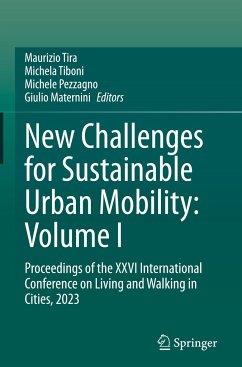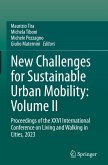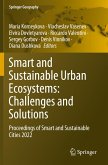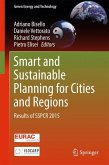New Challenges for Sustainable Urban Mobility: Volume I
Proceedings of the XXVI International Conference on Living and Walking in Cities, 2023
Herausgegeben:Tira, Maurizio; Tiboni, Michela; Pezzagno, Michele; Maternini, Giulio
New Challenges for Sustainable Urban Mobility: Volume I
Proceedings of the XXVI International Conference on Living and Walking in Cities, 2023
Herausgegeben:Tira, Maurizio; Tiboni, Michela; Pezzagno, Michele; Maternini, Giulio
- Gebundenes Buch
- Merkliste
- Auf die Merkliste
- Bewerten Bewerten
- Teilen
- Produkt teilen
- Produkterinnerung
- Produkterinnerung
This volume is the first of a two-volume set of the Proceedings of the XXVI International Conference on Living and Walking in Cities, held September 6-8 2023 at the University of Brescia, Italy. The LWC International Conference was first organized in 1994 at the Department of Civil and Environmental Engineering of the University of Brescia (IT). This year the LWC Conference has arrived at its XXVI edition. The Conference traditionally deals with the topics of urban mobility and quality of life in urban areas, with a specific focus on vulnerable road users. The LWC Conference allows…mehr
Andere Kunden interessierten sich auch für
![New Challenges for Sustainable Urban Mobility: Volume II New Challenges for Sustainable Urban Mobility: Volume II]() New Challenges for Sustainable Urban Mobility: Volume II177,99 €
New Challenges for Sustainable Urban Mobility: Volume II177,99 €![Sustainable Advanced Technologies for Environmental Management Sustainable Advanced Technologies for Environmental Management]() Sustainable Advanced Technologies for Environmental Management171,99 €
Sustainable Advanced Technologies for Environmental Management171,99 €![Advances in Environmental Sustainability Advances in Environmental Sustainability]() Advances in Environmental Sustainability139,99 €
Advances in Environmental Sustainability139,99 €![Advances in Photonics and Electronics Advances in Photonics and Electronics]() Advances in Photonics and Electronics161,99 €
Advances in Photonics and Electronics161,99 €![Smart and Sustainable Urban Ecosystems: Challenges and Solutions Smart and Sustainable Urban Ecosystems: Challenges and Solutions]() Smart and Sustainable Urban Ecosystems: Challenges and Solutions131,99 €
Smart and Sustainable Urban Ecosystems: Challenges and Solutions131,99 €![Beyond the Bulldozers: Can Green Initiatives Save Shrinking Cities? Beyond the Bulldozers: Can Green Initiatives Save Shrinking Cities?]() AlishaBeyond the Bulldozers: Can Green Initiatives Save Shrinking Cities?28,19 €
AlishaBeyond the Bulldozers: Can Green Initiatives Save Shrinking Cities?28,19 €![Smart and Sustainable Planning for Cities and Regions Smart and Sustainable Planning for Cities and Regions]() Smart and Sustainable Planning for Cities and Regions116,99 €
Smart and Sustainable Planning for Cities and Regions116,99 €-
-
-
This volume is the first of a two-volume set of the Proceedings of the XXVI International Conference on Living and Walking in Cities, held September 6-8 2023 at the University of Brescia, Italy. The LWC International Conference was first organized in 1994 at the Department of Civil and Environmental Engineering of the University of Brescia (IT). This year the LWC Conference has arrived at its XXVI edition. The Conference traditionally deals with the topics of urban mobility and quality of life in urban areas, with a specific focus on vulnerable road users. The LWC Conference allows researchers, experts, administrators, and practitioners to gather and discuss policy issues, best practices, and research findings from different perspectives. The main theme of the 2023 conference was "new challenges for sustainable urban mobility", and the papers herein address the issue from a multidisciplinary perspective and cover a wide variety of related topics. These books are divided into four topical sections:
oTransport Systems and Pedestrian Mobility
oUrban Regeneration through Active Mobility
oPublic Transport: New Technologies and Economic Sustainability
oSafe Mobility in Cities
oTransport Systems and Pedestrian Mobility
oUrban Regeneration through Active Mobility
oPublic Transport: New Technologies and Economic Sustainability
oSafe Mobility in Cities
Produktdetails
- Produktdetails
- Verlag: Springer / Springer Nature Switzerland / Springer, Berlin
- Artikelnr. des Verlages: 978-3-031-62247-2
- 2024
- Seitenzahl: 364
- Erscheinungstermin: 10. August 2024
- Englisch
- Abmessung: 241mm x 160mm x 24mm
- Gewicht: 720g
- ISBN-13: 9783031622472
- ISBN-10: 3031622472
- Artikelnr.: 70518473
- Herstellerkennzeichnung Die Herstellerinformationen sind derzeit nicht verfügbar.
- Verlag: Springer / Springer Nature Switzerland / Springer, Berlin
- Artikelnr. des Verlages: 978-3-031-62247-2
- 2024
- Seitenzahl: 364
- Erscheinungstermin: 10. August 2024
- Englisch
- Abmessung: 241mm x 160mm x 24mm
- Gewicht: 720g
- ISBN-13: 9783031622472
- ISBN-10: 3031622472
- Artikelnr.: 70518473
- Herstellerkennzeichnung Die Herstellerinformationen sind derzeit nicht verfügbar.
Maurizio Tira Maurizio Tira is Full Professor of Urban planning at the University of Brescia (I), member of the Academy of Sciences of Bologna and member of the board of the European University Association. He has been President of the Italian Urban Planners' Society and he acted as Rector of the University of Brescia from November 1 st 2016 until 31 st October 2022. In that role, he was delegate for international affairs within the Board of the Italian Rectors' Conference. He has been member of the Technical Structure of the Italian Ministry of Transport and Infrastructures from 2017 to 2018 and he is at present member of the Transport Research Committee of OECD-ITF and of the DG Move Expert Group on Urban mobility. He is President of "GARR, the ultra-broadband network dedicated to the Italian research and education community". He participated in several EU funded projects mainly in the field of urban and mobility planning, focusing on the urban safety management, publishing 275 scientific works. In December 2020, the President of the Italian Republic made him Commander of the Italian Republic. Michela Tiboni Michela Tiboni, born in 1970, is a Civil Engineer and Full Professor of Urban Planning. Since 1996, Tiboni has been at the forefront of scientific research, collaborating with national and international institutes on various projects. Her focus spans from urban planning to Geographic Information Systems (GIS), utilizing innovative techniques to analyze and address urban challenges, territorial planning in high-risk areas, emphasizing vulnerability and exposure within established cities. She also explores accessibility and safety in urban environments, pioneering methodologies to enhance safety and studying accident phenomena, especially among vulnerable users. Her commitment extends beyond academia; she actively engages in civic leadership roles, notably as Councilor for Urban Planning and Sustainable Development in Brescia. The approach in sustainable urban development aimed at revitalizing urban areas and improving citizens' quality of life. Michele Pezzagno Michele Pezzagno serves as an Associate Professor of Urban and Landscape Planning at the University of Brescia, Italy. She leads the University Research and Documentation Center for the 2030 Sustainable Development Agenda (CRA2030). Her research primarily revolves around developing technical planning strategies for fostering sustainable development within urbanized regions. Author of more than 130 publications, she also dedicates her teaching efforts to topics such as participatory planning and engaging citizens in sustainable urban development. Giulio Maternini Giulio Maternini is Full Professor in Transport Engineering at the University of Brescia. He is a member of the Scientific Committee of CeSCAM and has assumed the role of Director since 2019. Since 2004, he has served as the Rector's Delegate for Sustainable Mobility, showcasing his commitment to enhancing sustainable transport systems. Since 1998, he has been involved in AIIT (Italian Association for Traffic and Transport Engineering), where he became National Vice-President (2007-2010) and National President (2010-2014). He is a member of the Scientific Association SIIV (Italian Road Infrastructure Society) and SIDT (Italian Society of Transportation Academicians). Since 2018, he has been the Editor of the European Transport/Trasporti Europei. He has spearheaded numerous research initiatives focused on safety and mobility in urban areas, collaborating extensively with local governments, underlining his dedication to improving public transport and road safety standards.
Chapter 1: Promoting accessibility through active mobility for sustainable and inclusive cities. An Inclusive Accessibility by Proximity Index (IAPI).- Chapter 2: High Performance Wheelchair. Wheelchair mobility performance enhancement based on technological applications.- Chapter 3: Active Mobility behaviours contributing to Sustainable Development Goals.- Chapter 4: From school to city. An analysis on 600 school squares towards designing urban places for and with active mobility.- Chapter 5: A review of criticism to walkability: when the walkable approach is not a good idea?.- Chapter 6: Living and Walking in Campuses: the case of the University of Catania.- Chapter 7: The role of universities in promoting sustainability through active mobility in daily commuting.- Chapter 8: Analysing The Pedestrian Mobility in Urban Public Space: The Case Study of Mersin Kushimato Street and Uray Street.- Chapter 9: Pedestrian Movement and Access to Public Services, Mezitli-Mersin, Turkey.- Chapter 10: A Multi-Scalar Assessment of Urban Heat Effects on Walkability in Ankara.-
Chapter 11: The "X-minute city": Milan from the idea of proximity to the creation of a quality public city.- Chapter 12: Walking city, Automobile city, and Sustainable city. Urban structures and mobility patterns for reuse the spaces of the automobile era.- Chapter 13: Integrating the TOD and 15-minute City concepts in the analysis of rail station areas: a methodological approach for a case study in Palermo (Italy).- Chapter 14: Sustainable mobility and the X-minute city. The case study of Berlin and Teheran.- Chapter 15: Improving walkability in the city. Urban and personal "comfort" and the need for cultural shifts.- Chapter 16: Walkability and rebalancing of centralities in a city under reconstruction.- Chapter 17: The role of transport in urban regeneration. The neighborhood Le Albere in Trento throught the lens of GBC Quartieri.- Chapter 18: A cycling indicator for tourism accessibility evaluation in urban areas.- Chapter 19: Environmental and operational efficiency of integrated Urban last-mile freight distribution systems based on the use of cargo bikes.- Chapter 20: The challenges of implementing pedestrian-focused interventions using a multi-stakeholder approach - the case study of Malta.- Chapter 21: Revitalization, development, and integration of rail system in urban areas - Zadar Urban Area Case Study.- Chapter 22: Sustainable mobility in the urban and metropolitan areas of Mediterranean.- Chapter 23: Coastal roads. An Atlas for the socio-ecological transition of coastal territories.- Chapter 24: Participatory process for upgrading public spaces through sustainable mobility and social inclusiveness.- Chapter 25: Different conceptions of Active Mobility: how cyclability is planned in the world. Case study investigation.- Chapter 26: Embedding green infrastructure in urban regeneration projects.- Chapter 27: Urban Regeneration Through Large Urban Projects - Case Study of Traffic Analysis As Urban Planning Method.- Chapter 28: The intertemporal issue of low hourly occupancy of loading/ unloading parking spaces in the city of Thessaloniki.- Chapter 29: Hybrid Urban Services, Proximity Growth and Digital Connectivity.- Chapter 30: The experimentation of tactical urbanism as a tool for adaptation to climate change. The SpaziAttivi itinerary of the city of Brescia.
Chapter 11: The "X-minute city": Milan from the idea of proximity to the creation of a quality public city.- Chapter 12: Walking city, Automobile city, and Sustainable city. Urban structures and mobility patterns for reuse the spaces of the automobile era.- Chapter 13: Integrating the TOD and 15-minute City concepts in the analysis of rail station areas: a methodological approach for a case study in Palermo (Italy).- Chapter 14: Sustainable mobility and the X-minute city. The case study of Berlin and Teheran.- Chapter 15: Improving walkability in the city. Urban and personal "comfort" and the need for cultural shifts.- Chapter 16: Walkability and rebalancing of centralities in a city under reconstruction.- Chapter 17: The role of transport in urban regeneration. The neighborhood Le Albere in Trento throught the lens of GBC Quartieri.- Chapter 18: A cycling indicator for tourism accessibility evaluation in urban areas.- Chapter 19: Environmental and operational efficiency of integrated Urban last-mile freight distribution systems based on the use of cargo bikes.- Chapter 20: The challenges of implementing pedestrian-focused interventions using a multi-stakeholder approach - the case study of Malta.- Chapter 21: Revitalization, development, and integration of rail system in urban areas - Zadar Urban Area Case Study.- Chapter 22: Sustainable mobility in the urban and metropolitan areas of Mediterranean.- Chapter 23: Coastal roads. An Atlas for the socio-ecological transition of coastal territories.- Chapter 24: Participatory process for upgrading public spaces through sustainable mobility and social inclusiveness.- Chapter 25: Different conceptions of Active Mobility: how cyclability is planned in the world. Case study investigation.- Chapter 26: Embedding green infrastructure in urban regeneration projects.- Chapter 27: Urban Regeneration Through Large Urban Projects - Case Study of Traffic Analysis As Urban Planning Method.- Chapter 28: The intertemporal issue of low hourly occupancy of loading/ unloading parking spaces in the city of Thessaloniki.- Chapter 29: Hybrid Urban Services, Proximity Growth and Digital Connectivity.- Chapter 30: The experimentation of tactical urbanism as a tool for adaptation to climate change. The SpaziAttivi itinerary of the city of Brescia.
Chapter 1: Promoting accessibility through active mobility for sustainable and inclusive cities. An Inclusive Accessibility by Proximity Index (IAPI).- Chapter 2: High Performance Wheelchair. Wheelchair mobility performance enhancement based on technological applications.- Chapter 3: Active Mobility behaviours contributing to Sustainable Development Goals.- Chapter 4: From school to city. An analysis on 600 school squares towards designing urban places for and with active mobility.- Chapter 5: A review of criticism to walkability: when the walkable approach is not a good idea?.- Chapter 6: Living and Walking in Campuses: the case of the University of Catania.- Chapter 7: The role of universities in promoting sustainability through active mobility in daily commuting.- Chapter 8: Analysing The Pedestrian Mobility in Urban Public Space: The Case Study of Mersin Kushimato Street and Uray Street.- Chapter 9: Pedestrian Movement and Access to Public Services, Mezitli-Mersin, Turkey.- Chapter 10: A Multi-Scalar Assessment of Urban Heat Effects on Walkability in Ankara.-
Chapter 11: The "X-minute city": Milan from the idea of proximity to the creation of a quality public city.- Chapter 12: Walking city, Automobile city, and Sustainable city. Urban structures and mobility patterns for reuse the spaces of the automobile era.- Chapter 13: Integrating the TOD and 15-minute City concepts in the analysis of rail station areas: a methodological approach for a case study in Palermo (Italy).- Chapter 14: Sustainable mobility and the X-minute city. The case study of Berlin and Teheran.- Chapter 15: Improving walkability in the city. Urban and personal "comfort" and the need for cultural shifts.- Chapter 16: Walkability and rebalancing of centralities in a city under reconstruction.- Chapter 17: The role of transport in urban regeneration. The neighborhood Le Albere in Trento throught the lens of GBC Quartieri.- Chapter 18: A cycling indicator for tourism accessibility evaluation in urban areas.- Chapter 19: Environmental and operational efficiency of integrated Urban last-mile freight distribution systems based on the use of cargo bikes.- Chapter 20: The challenges of implementing pedestrian-focused interventions using a multi-stakeholder approach - the case study of Malta.- Chapter 21: Revitalization, development, and integration of rail system in urban areas - Zadar Urban Area Case Study.- Chapter 22: Sustainable mobility in the urban and metropolitan areas of Mediterranean.- Chapter 23: Coastal roads. An Atlas for the socio-ecological transition of coastal territories.- Chapter 24: Participatory process for upgrading public spaces through sustainable mobility and social inclusiveness.- Chapter 25: Different conceptions of Active Mobility: how cyclability is planned in the world. Case study investigation.- Chapter 26: Embedding green infrastructure in urban regeneration projects.- Chapter 27: Urban Regeneration Through Large Urban Projects - Case Study of Traffic Analysis As Urban Planning Method.- Chapter 28: The intertemporal issue of low hourly occupancy of loading/ unloading parking spaces in the city of Thessaloniki.- Chapter 29: Hybrid Urban Services, Proximity Growth and Digital Connectivity.- Chapter 30: The experimentation of tactical urbanism as a tool for adaptation to climate change. The SpaziAttivi itinerary of the city of Brescia.
Chapter 11: The "X-minute city": Milan from the idea of proximity to the creation of a quality public city.- Chapter 12: Walking city, Automobile city, and Sustainable city. Urban structures and mobility patterns for reuse the spaces of the automobile era.- Chapter 13: Integrating the TOD and 15-minute City concepts in the analysis of rail station areas: a methodological approach for a case study in Palermo (Italy).- Chapter 14: Sustainable mobility and the X-minute city. The case study of Berlin and Teheran.- Chapter 15: Improving walkability in the city. Urban and personal "comfort" and the need for cultural shifts.- Chapter 16: Walkability and rebalancing of centralities in a city under reconstruction.- Chapter 17: The role of transport in urban regeneration. The neighborhood Le Albere in Trento throught the lens of GBC Quartieri.- Chapter 18: A cycling indicator for tourism accessibility evaluation in urban areas.- Chapter 19: Environmental and operational efficiency of integrated Urban last-mile freight distribution systems based on the use of cargo bikes.- Chapter 20: The challenges of implementing pedestrian-focused interventions using a multi-stakeholder approach - the case study of Malta.- Chapter 21: Revitalization, development, and integration of rail system in urban areas - Zadar Urban Area Case Study.- Chapter 22: Sustainable mobility in the urban and metropolitan areas of Mediterranean.- Chapter 23: Coastal roads. An Atlas for the socio-ecological transition of coastal territories.- Chapter 24: Participatory process for upgrading public spaces through sustainable mobility and social inclusiveness.- Chapter 25: Different conceptions of Active Mobility: how cyclability is planned in the world. Case study investigation.- Chapter 26: Embedding green infrastructure in urban regeneration projects.- Chapter 27: Urban Regeneration Through Large Urban Projects - Case Study of Traffic Analysis As Urban Planning Method.- Chapter 28: The intertemporal issue of low hourly occupancy of loading/ unloading parking spaces in the city of Thessaloniki.- Chapter 29: Hybrid Urban Services, Proximity Growth and Digital Connectivity.- Chapter 30: The experimentation of tactical urbanism as a tool for adaptation to climate change. The SpaziAttivi itinerary of the city of Brescia.








